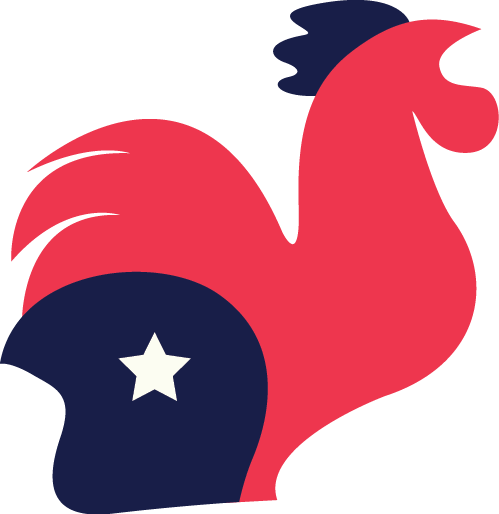
Get our Insider's Guide to Downtown Knoxville delivered straight to your inbox. We promise to send you only the good stuff.



















































































The Body Farm
Located not too far from the University of Tennessee, there is an ominous 2.5 acres full of decomposing bodies. Don’t worry, it’s all for research. Started by William M. Bass III in 1981, the Body Farm is where UT’s Forensic Anthropology department simulates crime scenes and studies decaying bodies.
University of Tennessee
The University of Tennessee is a cornerstone of Knoxville. It was founded in 1794 just two years before Tennessee became America’s 16th state. UT boasts almost 28,000 students, nine undergraduate schools and 11 graduate schools. The iconic school colors were inspired by orange and white daisies found on a hill on UT’s campus. Now you’ll find the colors most places you go. Go Vols!
Knoxville Symphony Orchestra
The Knoxville Symphony Orchestra has been a bastion of Knoxville culture for nearly a century. Established in 1935, it is the oldest continuing orchestra in the southeastern United States. The founder and first conductor of the KSO was Bertha Walburn Clark. The KSO has grown to over 80 professional musicians and offers 250 programs each season.
Port of Knoxville
Believe it or not, you can get to the ocean from Knoxville. Located on the Tennessee River, the Port of Knoxville takes you to the Gulf of Mexico, the Atlantic Ocean and even the Great Lakes. The Port handles over half a million tons of shipments per year and nearly one thousand barges.
Cormac McCarthy
One of America’s most prolific novelists, Cormac McCarthy grew up in Knoxville and attended Knoxville Catholic High School and (briefly) the University of Tennessee. McCarthy has written several award-winning books like: Blood Meridian, No Country for Old Men, The Road and Suttree, a semi-autobiographical story based in Knoxville. In Suttree, McCarthy captures the essence of the hard, rural South. Readers will find familiar landmarks like Market Square, Blount Mansion and Henley Street bridge throughout his pages.
Cal Johnson
Cal Johnson was many things: a businessman, philanthropist, saloon proprietor and racetrack owner. Born into slavery, Johnson became a free man after the ratification of the 13th Amendment in 1865 and first gained employment as a cook. By the mid-1880s he had accumulated around $20,000 and bought the saloon where he once worked. Over the years, Johnson continued to buy saloons and eventually opened a horse racetrack in East Knoxville.
Johnny Knoxville
Everyone loves a good prank, but few more than Philip Clapp Jr. Taking his hometown as his stage name, Johnny Knoxville moved to California after graduating high school to pursue a career in entertainment. Viewers will recognize him as the co-creator and star of the MTV stunt show, Jackass. Knoxville also produces, writes and acts in TV and film–starring in movies such as: Men in Black II, The Dukes of Hazzard and Lords of Dogtown.
Extra, Extra!
Read all about it! The Knoxville Gazette, started by George Roulstone on November 5, 1791, was the first newspaper providing a voice and perspective in Tennessee. Competing papers also emerged. Adolph Ochs worked as an office boy at the Knoxville Chronicle after the Civil War and would go on to eventually purchase the New York Times. In 1886, John Trevis, founded The Sentinel. Robert P. Scripps and Roy W. Howard founded The Knoxville News. In 1921, Knoxville News absorbed the Sentinel to create the enduring paper we know today, The Knoxville News Sentinel.
JFG Coffee
“The Best Part of the Meal” is the slogan for this delicious drink. JFG’s story began in Morristown, TN where grocer, James Franklin Goodson, decided to make a superior coffee by roasting his own beans. By 1926, the Goodson family left behind their grocery business and moved to Knoxville to produce their increasingly popular JFG Coffee. From the large downtown roastery, their coffee helped ease the mornings for thousands in Knoxville and beyond.
Pat Summitt
For many, UT athletics is a way of life. Few embody the Volunteer spirit like Pat Summitt who was the women’s college basketball coach that led the Lady Vols from 1974 to 2012 along with a special 1997 undefeated season and compiling 1,098 game wins, the most in college basketball history at the time. She also won 8 NCAA championships, an Olympic silver medal, the Presidential Medal of Freedom, among other prestigious awards over the course of her career.
1982 World's Fair
Ever wonder what that giant golden globe on the skyline is? That’s the Sunsphere! It was built for the 1982 World’s Fair, hosted here in Knoxville. Even though it was the smallest city to host a World’s Fair, Knoxville saw 11 million visitors with 22 nations participating. The fair generated massive attention for the city and a whopping profit of $57 -- just shy of the projected $5 million. A visit to World’s Fair Park provides even more information about this spectacular event.
Zoo Knoxville
Lions, tigers, bears and more! Zoo Knoxville has them all. In 1951, what started as a local children’s park was reclaimed and renamed as the Municipal Zoo. The zoo’s first attraction was an alligator named Al. In 1971, Guy and Patty Smith along with the help of Dr. Bill Patterson raised money to launch the modern Zoo Knoxville we know today. More than 400,000 visitors come each year to see over 800 animal residents in this 53-acre oasis.
Charles McGhee Tyson
Charles or “Tys”, the son of Lawrence and Bettie Tyson, lived a storybook life: influential parents, Ivy-league education, and World War I aviator. McGhee Tyson was two when his parents moved to Knoxville so his father could oversee UT's military science program. After graduating Princeton and managing his father’s textile company, McGhee Tyson enlisted in the Navy where he was killed in an accident on the North Sea. To honor his memory, his mother donated land to have the Knoxville airport named after him. To this day, it remains the McGhee Tyson Airport.
Riverboats
To early Knoxville residents and businesses, access to the river was essential to connect with other cities across the region. In 1828, the city offered a reward to steamboat Atlas for being the first to dock, coming all the way from Muscle Shoals. River commerce and travel remained important until the early 1900s when more and more railroads were built. A ride down the Tennessee river is one of the best ways to take in the natural beauty.
Church of the Immaculate Conception
In 1885, Knoxville’s first Roman Catholic parish was founded for the city’s growing Catholic congregation and Irish community: Church of the Immaculate Conception. The church was designed by one of Knoxville’s first professional architects, Joseph Baumann, in the Victorian Gothic style. The historic church has served as a place of worship for many Knoxvillians and remains active to this day.
Dogwood Arts
In the 1947 book, Inside U.S.A., John Gunther said Knoxville had, "an intense, concentrated, degrading ugliness." Civic leaders leapt into action and began beautification efforts. One of which was to create dogwood trails. Before long, the dogwood trees bloomed then the Dogwood Arts Festival was created to celebrate the beauty and culture of Knoxville. It attracts a quarter-million visitors each year. The festival is rich with music, food, crafts, and of course, dogwoods.
Dempster Dumpster
They say one man’s trash is another man’s treasure. In the case of George Dempster, nothing could be more true. Growing up in Knoxville, Dempster and his brothers had a slew of businesses until they came up with their million-dollar idea: the first large-scale waste container that could be mechanically emptied into a garbage truck. You guessed it! The Dempster Dumpster. The success of the business propelled Dempster into the political arena culminating in a brief stint as mayor in 1946.
Ijams Nature Center
Founded by Harry and Alice Ijams as the “Bird Sanctuary”, this South Knoxville fixture became a public park through the hard work of the Ijams family, Knoxville garden clubs and the City of Knoxville. This 315-acre nature center is where Knoxvillians can hike, bike, paddle, climb–or simply enjoy the day outside.
Peyton Manning
If it’s Saturday in the fall, chances are you’ll hear the rumble of fans churning from Neyland Stadium as they cheer on one of the city’s favorite traditions: University of Tennessee football. Few epitomize the team like quarterback, Peyton Manning. Manning led the team to an SEC Championship in a legendary comeback against Auburn his senior year. After college, Manning went on to play in the NFL, first for the Indianapolis Colts and then for the Denver Broncos. He appeared in four Super Bowls and winning two of them.
James Agee
“You must be in tune with the times and prepared to break with tradition,” reflected James Agee. Born in Knoxville, Agee went on to become a prominent poet, novelist, journalist, screenwriter, and film critic. His most notable works were: Let Us Now Praise Famous Men and A Death in the Family the autobiographical set in Fort Sanders.
Knoxville Botanical Garden
Knoxville Botanical Garden and Arboretum dates back to well before Tennessee was ratified. In 1780, the newly founded U.S. government gave David Wessel Howell a 14-acre plot of land for service in the Revolutionary War. Howell set up a family farm, planted fruits and vegetables, then sold them locally. The land and business flourished as it passed down the Howell family line. In 2002, Jenny Howell sought to preserve her family’s profession, passion and legacy by establishing a non-profit with the original Howell land. Thus, Knoxville Botanical Garden and Arboretum was born.
Big John Tate
They didn’t call him “Big John” for nothing. At 6'4" and with a reach of 80 inches, John Tate was a professional heavyweight boxer and a force to be reckoned with. Tate lived in Knoxville and worked in sanitation as he trained for his professional career. He would go on to hold the WBA heavyweight title from 1979 to 1980 and win a bronze medal in the heavyweight division at the 1976 Summer Olympics.
Scott Kelly
Scott Kelly is most notably an astronaut. With 4 space flights, 3 expeditions and 520 days spent in space, Kelly is one of America’s most seasoned astronauts. In fact, 340 of those days were spent consecutively in orbit from March 27, 2015, to February 29, 2016. Kelly received his M.S. degree in Aviation Systems from the University of Tennessee in 1996.
Radio
Originally started as WNAV in 1921, WNOX is one of the ten oldest radio stations in the U.S. It showcased major talents in the burgeoning hillbilly, country, and folk music scene from the 1930s through the 1950s. Today, our local WDVX carries that same spirit with the Blue Plate Special, a live music performance that takes place most days at noon in the Knoxville Visitor Center.
Min Kao
Min H. Kao was born in a small town in Taiwan. After completing his undergraduate studies, Kao attended the University of Tennessee to pursue his doctorate in electrical engineering. At AlliedSignal, Kao met fellow engineer, Gary Burrell and established a global positioning company: Garmin. Their first office was a card table with two folding chairs. Originally built for aviation and boating, the Garmin GPS eventually expanded to include directions for roads and highways. In 2005, Kao gave a large gift to UT to build the aptly named Min Kao Electrical Engineering and Computer Science Building.
Sterchi's Furniture
In 1888, James Sterchi and his brothers J.C. and E.H. formed the Sterchi Brothers Furniture Company in Knoxville, with just $800. By 1929, their company became the largest furniture chain in the world with 48 stores and 5 manufacturing plants. Sterchi’s also became the first Knoxville-based firm to be listed on the New York Stock Exchange. Their ten-story headquarters, now called Sterchi Lofts, still stands prominently on Gay Street.
White Lily Flower
There are few things Southerners take as seriously as their cooking and White Lily Flour is the secret to that perfect, weightless biscuit. Milled in Knoxville since 1883, White Lily’s fine, silky flour comes from soft winter wheat. Known to some as the “Sunday Flour,” White Lily remains a staple in kitchens throughout the region.
David Farragut
Born near Knoxville, David Farragut was a flag officer of the United States Navy during the American Civil War. His most notable victory was at the Battle of Mobile Bay in August 1864 where he famously proclaimed, “Damn the torpedoes, full speed ahead!” commanding his fleet to ignore Confederate defenses in the harbor. His namesake lives on in the town of Farragut, a suburb of Knoxville.
Kurt Vonnegut
Kurt Vonnegut was a celebrated counterculture author and intellectual. If you remember your high school English class, you probably read Slaughterhouse-Five, his dark, satirical novel that went on to top The New York Times Best Seller list. During WWII, Vonnegut attended the University of Tennessee to study mechanical engineering and spent a brief stint in Knoxville.
Henley Street Bridge
The Henley Street Bridge crosses the Tennessee River to connect our beautiful downtown with South Knoxville. Named after Colonel David Henley, a Revolutionary War officer, the bridge was built in 1931 and spans 1,793 feet. Through much turmoil, the bridge was finally completed and remains a fixture of Knoxville to this day. The bridge even shows up in three of Cormac McCarthy’s novels.
Clarence Brown
Lights, camera, action! Although born in Massachusetts, Clarence Brown moved to Knoxville when he was 11 years old. Attending Knoxville High School and the University of Tennessee, Brown went on to become a popular film director in the mid-1900s. Over his lifetime, Brown’s films earned 38 Academy Award nominations and 9 Oscars. The Clarence Brown Theater on UT’s campus is named in his honor. After retirement, Brown reportedly stopped watching new movies for fear he would restart his career.
Alex Haley
Alex Haley was an African-American writer and the author of the book Roots: The Saga of an American Family. Adapted as a television miniseries with the same name, it aired to a record-breaking audience of 130 million viewers. Roots cataloged his family's story, going back to slavery and serving to raise awareness of black history and genealogy. Late in life, Haley acquired a farm near Knoxville where he continued to prompt national conversation.
William H. Hastie
A Knoxville native through and through, William Hastie was America’s first black governor. Born in Knoxville as the son of a clerk and a schoolteacher, Hastie was a great student and eventually earned two degrees from Harvard Law School. He subsequently began working as an attorney for the U.S. Department of the Interior. In 1946, Hastie was appointed as governor of the U.S. Virgin Islands by President Harry Truman, making him the first black governor of a U.S. state or territory.
Patricia Neal
Patricia Neal was an Academy Award-winning actress starring in films like The Day the Earth Stood Still, Breakfast at Tiffany's and Hud. Although born in Kentucky, she grew up in Knoxville and attended Knoxville High School. Despite a tumultuous family life, Neal was resilient and strong, ultimately becoming an advocate for paralysis victims. Her legacy lives on through the memories of her many friends and family still in the area and the Patricia Neal Rehabilitation Center.
Mountain Dew
What happens when two brothers can’t find the right soda to mix with their whiskey? They make their own. Tennessee bottlers Barney and Ally Hartman crafted their own soda recipe in the 1940s naming it after the generic term for Highland Scotch whiskey: Mountain Dew. The rights were eventually bought and the flavor altered, but the sugary, green drink has its humble beginnings right in our backyard.
Hank Williams Sr.
Known to many as “The King of Country Music,” Hank Williams was one of America’s most significant and influential songwriters. On a short tour in 1952, Williams became ill, encountered bad weather and was forced to spend the night at the Andrew Johnson Hotel in downtown Knoxville. He reportedly died the next day on his way to Ohio. What caused his death and where it actually occurred remains a mystery.
Lizzie Crozier French
No movement succeeds without local champions bringing about change in their communities. Born in Knoxville in 1851, Lizzie Crozier French was an educator turned activist for the women of Tennessee. One of the primary leaders in the fight for women's rights, French helped Tennessee become the 36th state to give women the right to vote in 1920. She also founded the Ossoli Circle, the oldest federated women's club in the South.
Frank McClung
A descendant of Knoxville founder, James White, Frank McClung has deep Knoxville roots. Young McClung was a founding partner of the Knoxville mercantile firm Cowan, McClung & Company in 1858. His daughter and son-in-law, Judge John and Mrs. Ellen McClung Green, honored his memory by funding a museum at the University of Tennessee: McClung Museum of Natural History & Culture. More than 1.4 million visitors have enjoyed the museum's variety of programs and exhibits.
Dog Friendly
Looks like Knoxville has gone to the dogs. With so much natural beauty in the area, Knoxville ranks as one of the best cities in the region for dog owners. From our parks to our restaurants, dog lovers will find many places to explore with their furry friends.
Quentin Tarantino
Widely considered one of the greatest filmmakers of his generation, Academy Award-winner, Quentin Tarantino is known for cult classics like Reservoir Dogs, Pulp Fiction and Kill Bill. Born in Knoxville, Tarantino moved to LA with his mother where he became fascinated with movies, acting and screenwriting. In fifth grade, he returned to the area with his grandparents and would often visit the South Clinton Drive-in Theater. His experience in East Tennessee made its way into many of his characters, settings and stories.
Railroads
All aboard! The Knoxville railroad has seen its fair share of history. By the early 1900s, passenger trains stopped in Knoxville day and night. At the corner of Gay Street and Depot, four hotels were built to accommodate the steady stream of passengers. The railroad brought all kinds of spectacles and celebrities through Knoxville: Elvis, President Howard Taft, P.T. Barnum, the Liberty Bell, shipwrecks and even a dead whale that people paid 10 cents to see.

